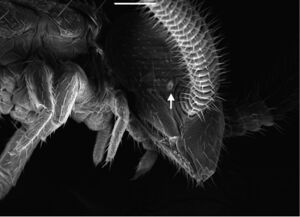Biology:Organ of Tömösváry
From HandWiki

Tömösváry organ (arrow) on the head of a symphylan, just behind the base of an antenna
Tömösváry organs, also known as temporal organs or postantennal organs[1] are specialized paired sensory organs found in certain groups of myriapods (e.g. centipedes and millipedes) and hexapods (e.g. springtails), located on the head near the base of the antennae. They are notably absent among Polydesmid (flat-backed millipedes), the largest order of Diplopoda.[2] Various functions for the Tömösváry organs have been proposed, including sensing vibration, humidity, or light, although evidence for their true function is conflicting, and in groups such as millipedes its true function is unknown.[3][4] The organs were first described by Hungarian biologist Ödön Tömösváry in 1883.
References
- ↑ Gordh, G.; Headrick, D.H. (2009). A Dictionary of Entomology (2nd ed.). Wallingford: CABI. p. 979. ISBN 9781845935429. https://books.google.com/books?id=9IcmCeAjp6cC&pg=PA979.
- ↑ Moritz, Leif; Koch, Markus (2020). "No Tömösváry organ in flat backed millipedes (Diplopoda, Polydesmida)". ZooKeys (930): 103–115. doi:10.3897/zookeys.930.48438. ISSN 1313-2989. PMID 32390750.
- ↑ Lewis, J. G. E. (2008). The Biology of Centipedes (Digitally printed 1st paperback version. ed.). Cambridge: Cambridge University Press. pp. 110–111. ISBN 9780521034111.
- ↑ Sierwald, Petra; Bond, Jason E. (2007). "Current Status of the Myriapod Class Diplopoda (Millipedes): Taxonomic Diversity and Phylogeny". Annual Review of Entomology 52 (1): 401–420. doi:10.1146/annurev.ento.52.111805.090210. PMID 17163800.
 |

